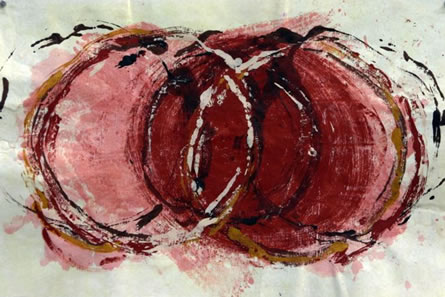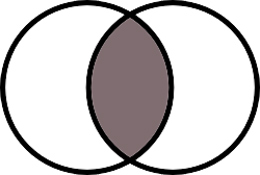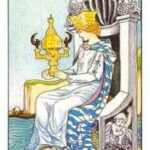 While empowering our masculine sides was a necessary phase of our psycho-spiritual development, our ego’s repression of our feared and unknown feminine sides has brought about the dangerous imbalances we see in today’s world. But to put all the blame on males and masculine values—or the patriarchies, Gods and religions they created—is just more projecting.
While empowering our masculine sides was a necessary phase of our psycho-spiritual development, our ego’s repression of our feared and unknown feminine sides has brought about the dangerous imbalances we see in today’s world. But to put all the blame on males and masculine values—or the patriarchies, Gods and religions they created—is just more projecting.
The truth is that we are all still divided and incomplete. The Great Mystery of Life some call God didn’t deliberately punish Adam and Eve and the people of Babel any more than it wants to punish us. It wants us to grow into our fullness, but our divided egos are resisting it with all their strength.
There is a time for everything. The dualism that gave rise to our evolving ego and developing Christ potential has become our worst enemy: the anti- Christ. And as long as we repress unwanted parts of ourselves and project them onto others—whether these be our compulsive instincts, dangerous emotions, or frightening aspects of our masculine and feminine sides—we will struggle through the darkness of confusion and the world will be a dangerous place.
Fortunately, our inborn urge to transcend our limitations is still at work. For the first time in human history, the relatively new science of psychology is revealing the unconscious forces within us that led us to this precipice, and this understanding is expanding our conscious awareness. We are seeing that the cherished God-image of a Father/God/ King who is an objective reality beyond ourselves and prefers our tribe to any other is a product of dualistic thinking which has created religious bigotry, divisiveness, narrow-mindedness, repression, persecution, fanaticism, and terrorism.
The extreme polarization that permeates society today is intolerable to most of us. But what can you and I possibly do if the world’s greatest thinkers, philosophers, political leaders and spirit persons have failed to create healing change? Does it make sense to redouble our commitment to the very thought- patterns and ideologies that brought us to this point, or are we ready for radical change? And if we are, what might healthy change look like?
A lifetime of searching has led me to a path that works for me. There’s nothing new about it. Every mystic and authentic spirit person from every religion has always known about it. It exists in us. This is a way of humble, intentional, and persistent self-examination in service to accepting our true selves and consciously connecting all pairs of opposites into integrated wholeness. I call it the path of Mandorla Consciousness.
 Imagine two circles that move toward each other until they overlap. One circle represents your conscious ego. The other, everything you don’t know or like about yourself that you’ve rejected and relegated to your unconscious. The almond-shaped symbol created by their merging is a mandorla: a central meeting place where your ego conducts imaginative dialogues with the dreams, images, forces, and characters from your unconscious. Authentic religions have long considered this a holy place of transformation and transcendence because religions are founded on compassion, and compassion requires connection with otherness.
Imagine two circles that move toward each other until they overlap. One circle represents your conscious ego. The other, everything you don’t know or like about yourself that you’ve rejected and relegated to your unconscious. The almond-shaped symbol created by their merging is a mandorla: a central meeting place where your ego conducts imaginative dialogues with the dreams, images, forces, and characters from your unconscious. Authentic religions have long considered this a holy place of transformation and transcendence because religions are founded on compassion, and compassion requires connection with otherness.
Our potential for Mandorla Consciousness is the same potential humanity once associated with Sophia’s holistic wisdom. But before we can return to this holy space and know it for what it truly is, we need to undergo the initiatory ordeal of suffering into consciousness. We need to see our resistance to the pain of growing. We need to understand that our ancestors justified their fear of change by imagining a God who didn’t want them to change either. We need to admit to our own fears, and experience the sacred healing power of love that sleeps at our core and is unveiled when we open ourselves to otherness.
Our hope for personal and world peace lies in self-discovery. This work begins as we acknowledge our individual and cultural shadows, and it comes to fruition when we invite our disowned masculine and feminine sides into our awareness. By facing our own capacity for evil as well as good, we will acquire humility and compassion for others. By accepting our soul’s potential for wholeness we will free ourselves from the chains of inferiority and self-hate. And by honoring the nobility and worth of our inner Mother/Queen and inviting her to enjoy equal partnership with our Father/King, we will integrate otherness and return to our true home: a conscious, evolving partnership with the Sacred Mystery of life.
Note: This post and the previous one were originally published by the Center for Action and Contemplation under the title, The Mandorla Consciousness. Radical Grace, Summer 2012, vol. 25, no 3, p. 18.
Image Credit: Mandorla, by Cicero Greathouse
Jean Raffa’s The Bridge to Wholeness and Dream Theatres of the Soul are at Amazon. Healing the Sacred Divide can be found at Amazon and Larson Publications, Inc. Jean’s new Nautilus Award-winning The Soul’s Twins, is at Amazon and Schiffer’s Red Feather Mind, Body, Spirit. Subscribe to her newsletter at www.jeanbenedictraffa.com.




16 Responses
Reblogged this on lampmagician.
Thank you for reblogging this.
Thank you Jeanie (genie) …it really is up to each and every one of us, in our own way to confront our shadows and dig deep, do the work. We can better understand the forces at work in the outer world e.g. our partnerships, parental upbringing, relationships, the politics of the world, and significantly, what tweaks our own complexes.
Interestingly to me, Babylon has come up THREE times this past week, since your last post. The last was this past Sunday when I attended a lecture on ancient symbols … the word was broken down: Ba Byl On …; but now I can’t find my notebook. ‘On’ I think referred to God. Also, the speaker mentioned Isaiah 45:7 in which God says He is both Good and Evil – to me this was a reminder that I contain all – and that I need to confront my own darkness in which the treasure can hopefully be found and divest myself of my conditioning and allow for the sacred Sophia to emerge.
Thanks, Susan. I love the synchronicity of “Babylon” coming up several times for you this week. I’ve never seen the word broken down but would love to know its ancient meaning. I’ll check it out.
I’m not surprised, however, to hear that even in Isaiah’s time Spirit people associated God with both Good and Evil. We know from experience that the Self (our God-image) contains both poles, like every archetype. And throughout history we’ve seen many examples of the “supernatural” forces we sense in ourselves being projected onto our deities and enacted in terrorist acts, cult killings (Jim Jones, etc.), witch burnings, pogroms, religious inquisitions, and genocides perpetrated in the name of God. Yes, somehow, so many people still fail to grasp the fact that they, too, contain both. It’s always the other guy who’s bad; never us!
Thank you for this helpful post. Your words never fail to move me in some way. I was particularly drawn to your statement: “We need to understand that our ancestors justified their fear of change by imagining a God who didn’t want them to change either.” I have been writing about that concept this past week, inspired by my reading of “Jesus Wars” by Philip Jenkins and Elaine Pagels’ “The Origin of Satan” (and, having read her book on the Gnostic Gospels, I came across a book that sounds intriguing called “Jung and the Lost Gospels”).
Hi, Darla. I appreciate knowing what it was about this post that moved you. It gives me ideas for future posts. In fact, I think you just gave me one for my next post! We’ll see if it pans out…
I love Pagels’ books, and think I’ve pretty much read them all. I also came across Jung and the Lost Gospels early in my Jungian studies. I bought it, read it, and remember being intrigued by it, though I couldn’t tell you now which parts of it were most helpful to me without going back and rereading the underlined sections. Sometimes when I do that I’m amazed to see where the seeds of some of my ideas came from and how they’ve blossomed into the way I think and live now.
Blessings on your writing. May it touch and move those who read it in meaningful ways…. For those who might be interested, here’s the link to your blog: https://onthegaiapath.wordpress.com
Jeanie
Thank you again, Jeanie. I’m taken with your comment that compassion requires integration with otherness. What a wonderful and simple way to state this essential truth. Protestant teachings in my childhood Presbyterian church were clear about the need to love the other and take care of the disadvantaged and suffering. Since then, this fundamental issue has often been pushed aside by less forgiving teachings. I’m grateful for the Dalai Lama who continues to make it clear that compassion is the essential issue. “Kindness is my religion.”
And thank you, Elaine. The only way I’ve learned compassion is to see my shadow mirrored in the responses of people I care for to the things I do and say. Had I lived my adult life as a hermit without close relationships, I could probably have sailed through life thinking that because I believed in the importance of compassion, and because I tried very hard to be a nice person, I truly was. It has been a rude awakening to discover that compassion is not about what you want to be or believe you are, but how you actually feel. About feeling patient and kindly toward someone whose actions are causing you frustration and stress. About feeling forgiving and understanding toward someone who’s hurt you, and not just saying or acting like everything’s fine when it really isn’t. Kindness…feeling it, living it in every moment…truly is the essential issue. Thanks so much for your valuable contribution to this subject.
So insightful as always! Warm aloha.
Thanks, Fran. Warm aloha to you too.
Thank you so much Jeanie for sharing your Mandorla Consciousness Parts I and II with us! Radical grace is a great way of describing the act of standing in our own overlapping places, with one foot in the world above, and the other, in the world below. Much like how shamans live all the time, although when in trance, they’re no longer here in this world, but in another.
Moving ourselves towards accepting this reality (that such a place exists) can be life-changing as we stop looking always outside of ourselves for solutions, validation, balance, etc. and understand that help, real help is available within. The first step being, to seek out those overlapping places and step into the mystery of our lives. Ostara blessings! Love and light, Deborah.
Oh, and it’s wonderful to read all these comments years later too! x
Thank you, Deborah. I love the term “radical grace” too, and you’ve described it perfectly here! It is, indeed, radical to live in your own overlapping space between opposites instead of always looking for validation from the outside. And extremely difficult. But it’s worth practicing and aiming for. As for Ostara blessings, it makes me smile to think that my beloved Christian grandparents unknowingly named my mother, Verna, after the pagan holiday that celebrates the spring, or vernal equinox. They would have had no idea of that growing up in a small rural town in MIchigan that was settled by Reformed Dutch Calvinist immigrants. Ostara blessings to you too on this second day of spring.
Hi, Jeane. It seems I have got an old post from you! However, it was nice to read it again.🥰💖
Yes, these latest two posts were first published in 2016. I occasionally repost older ones because of new followers who’ve never read them. 🙂
Mandorla … also known as the Venn Diagram – the womb of the universe.
Gilchrist introduces a root principle of Sacred Geometry, The Vesica Piscis.
https://www.youtube.com/watch?v=zoMk0estzXc
It has long intrigued me that without division there’d be no universe, no life.
Yes, thanks for adding your associations to this symbol. There must be opposites. There must be divisions. Without conflict there’s no energy or incentive to evolve. I’m reminded of E.M. Forster’s dictum: “Only connect.”